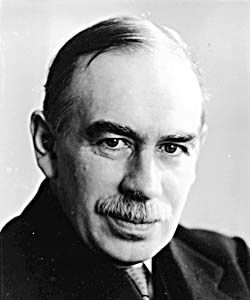John Maynard who? (part 2)
By Randell Tiongson on January 4th, 2010
… con’t.
The Philippine government tried to copy the same cheap money scenario but the local game was played very differently. The government pegged the interest rate very low, yet the bank’s borrowing rates were still stiff and did not really trickle to benefit the economy the way the government wanted it to. As a result, while there was some modest economic growth , it was a laggard by other country’s standards. When global financial institutions came crashing, the local financial companies stood their ground with nary a scratch. I got to give it to our Central Bank and sound local management to some point… but to a large degree, our local financial companies breezed through the storm unscathed because of the huge margins they enjoy. Imagine borrowing money at very cheap rates (thanks to the government) and lending them at high rates – how can you go wrong?
The first world economies and the Philippines applied what John Maynard Keynes advocates with different results. First world experienced unprecedented growth but their economy later succumbed into what appears to be a vacuum. The Philippines were spared from the financial mess but continues to await some economic epiphany that seems to be a dream. In my view, both results are failures.
Now, was John Maynard Keynes right? Should the government continue to craft policies to influence the economy? It seems that now more than ever, the Keynesian theory is alive – dole outs, stimulus packages & low interest rates; and we still claim that we subscribe to a free market? Hmmm, perplexing. Why don’t we just let the economy take its proper course; allow recession so we can learn from it; fix our houses, weed out inefficiencies and review our priorities? Allowing to do so will definitely be a painful and a hugely unpopular move. Or, we can continue applying band aid solutions to a necrotic wound.
There’s only one economy that can experience consistent growth with no recessions: God’s economy. Maybe it’s time we start focusing our time and effort in participating in His economy.
“So if you have not been trustworthy in handling worldly wealth, who will trust you with true riches?” – Luke 16:11, NIV.
A blessed New Year to everyone!
John Maynard who? (part 1)
By Randell Tiongson on December 31st, 2009
 John Maynard Keynes: 20th century economist and father of the ‘Keynesian’ Theory.
John Maynard Keynes: 20th century economist and father of the ‘Keynesian’ Theory.
What the heck is Keynesian Economics? Simply put, “it is a macroeconomic theory that argues that private sector decisions sometimes lead to inefficient macroeconomic outcomes and therefore advocates active policy responses by the public sector, including monetary policy actions by the central bank and fiscal policy actions by the government to stabilize output over the business cycle” (wikipedia.com). In other words, this is a theory that gives the government a huge say in the economy.
Governments, whether they admit it or not cling to Keyne’s theory like it’s the gospel truth especially now. Governments feel the need to dictate the direction of the economy as they feel that only government intervention can solve the crisis.
Really? Here’s a thought. Isn’t government, to a large degree, responsible for the mess we are in? When you really look at the root cause of many of today’s economic problems, one major thought comes into my mind – cheap money. Cheap money or a very low interest scenario allowed for an unrealistic prosperity that was not only unsustainable, it was bound to crash – and indeed, it crashed big time. Particularly in the US and Europe, the stock market took the cheap money and recklessly gambled with it; while people took it and wantonly spent it like there’s no tomorrow. Yes, cheap money allowed for growth but when you really look at it retrospectively, the growth made many reckless and deleted the word prudence in their vocabulary. In other words, it was a bubble.
… catch part 2
Remittances, growth forecast for developing Asia
By Randell Tiongson on December 19th, 2009
Philippine Remittances reach highest level
- A new record high for remittances was seen this Oct, reaching $1.53 bln.
- This was up by 6.7% Yoy and was better than the previous high of $1.49 bln established in the month of June.
- Remittances year to date totaled $14.3 bln, up 4.5% YOY
ADB raises growth forecast for developing Asia
- The Asian Development Bank raised growth forecasts for Asia’s developing economies
- Regional economies should grow +4.5% in 2009 and +6.6% in 2010.
- Three months ago the ADB’s forecast was a +3.9% in 2009 and +6.4% in 2010
- This signifies expectations of a V-shaped recovery for EMA
- Essentially, the higher forecast was due to better than expecetd growth in the third quarter of 2009.
- However they also warned against any “hasty withdrawal of stimulus packages”.
- “If done too soon, recovery may be at risk; if too late, fiscal deficits and monetary expansion could become unsustainable and inflationary.”
- Inflation is expected to be muted in short term but expected to pick up in medium term.
- Emerging markets expected to attract capital flows given higher growth relative to developed economies.
- Risk to EMA growth is a short-lived recovery of more developed global economies.

 John Maynard Keynes: 20th century economist and father of the ‘Keynesian’ Theory.
John Maynard Keynes: 20th century economist and father of the ‘Keynesian’ Theory.